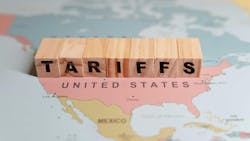Is the Hydraulics and Pneumatics Industry Concerned About Tariffs?
Tariffs are once again dominating the news cycle as a new round of them went into effect on March 12, this time specifically focused on steel and aluminum imported into the U.S. This comes one day after the Trump administration said it would impose a 50% tariff specifically on Canadian steel and aluminum in retaliation for one of Canada's provinces saying it would place a 25% tariff on electricity exported to the U.S.
And just last week, the previously paused tariffs on goods imported from Canada and Mexico were re-instated but then just as quickly put on pause again until April. Tariffs on Chinese goods were increased to 20%. Many countries have also implemented their own retaliatory tariffs on products coming from the U.S.
Stay up to Date on Tariffs
Implementation of tariffs, their amount and the products affected have changed a lot in recent weeks. Our colleagues at IndustryWeek have done a great job of collecting the updates as they happen as well as providing an overview of the current situation which you can read in the following articles:
Trump Revokes 50% Tariff Threat on Canadian Metals
US Trading Partners Hit Back on Blanket Steel, Aluminum Tariffs
For more of Power & Motion's coverage of tariffs and the potential affects on the fluid power industry, check out the following pieces:
Macroeconomic Trends to Watch in 2025
Will Tariffs Alter the Business Outlook for Fluid Power?
How Tariffs are Impacting Fluid Power, Electronics and Other Manufacturing Sectors
Needless to say, all of this back and forth on tariffs is causing a lot of headache for businesses, including those in the hydraulics and pneumatics sector.
When tariffs were first announced by the Trump administration in February, I spoke with a few members of the fluid power industry about their potential impacts. Needing to reasses supply chains, price increases and difficulty making business plans because of the continually evolving nature of the tariffs were some of the key challenges noted.
Essentially, tariffs are causing a lot of uncertainty for the industry and its many customer markets. For instance, the Association of Equipment Manufacturers' (AEM) tractor and combine reports for both January and February 2025 indicated concerns over global trade and tariffs as factors contributing to lower sales of agricultural equipment during the first 2 months of the year. This is one of the top customer markets for the fluid power industry; as such, lower demand in this segement could pose challenging for the hydraulics and pneumatics industry as well.
With the many changes that have been taking place over the past month in regards to tariffs, I wanted to check in with our readers to get their perspective on whether they see positive or negative impacts to the fluid power industry.
You can take the quick 1-question poll below to provide your insight, or feel free to reach out to me directly at [email protected].
About the Author
Sara Jensen
Executive Editor, Power & Motion
Sara Jensen is executive editor of Power & Motion, directing expanded coverage into the modern fluid power space, as well as mechatronic and smart technologies. She has over 15 years of publishing experience. Prior to Power & Motion she spent 11 years with a trade publication for engineers of heavy-duty equipment, the last 3 of which were as the editor and brand lead. Over the course of her time in the B2B industry, Sara has gained an extensive knowledge of various heavy-duty equipment industries — including construction, agriculture, mining and on-road trucks —along with the systems and market trends which impact them such as fluid power and electronic motion control technologies.
You can follow Sara and Power & Motion via the following social media handles:
X (formerly Twitter): @TechnlgyEditor and @PowerMotionTech
LinkedIn: @SaraJensen and @Power&Motion
Facebook: @PowerMotionTech

Leaders relevant to this article:

